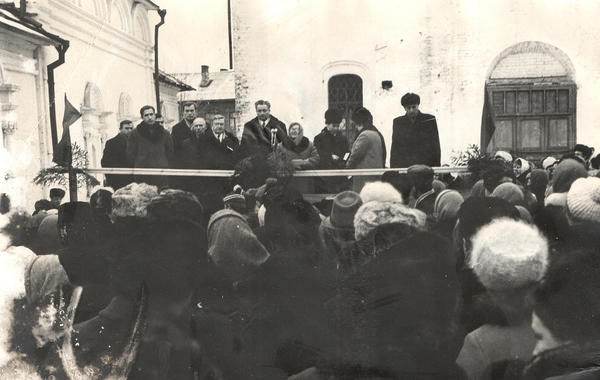The history of the museum began in the 1960s, when enthusiasts, who collected materials about their native land, and local historians, who studied its centuries-old history, emerged. At the same time, an initiative group was created, which was engaged in sourcing artifacts from local residents.

55
Gorokhovets History and Architecture Museum
#2
#11
However, the museum in the building of the Church of John the Baptist of the Annunciation Cathedral opened only on December 24, 1972. Here is what the newspaper “New Life” from December 30, 1972 wrote about this event.
#12
On a clear December day, hundreds of Gorokhovets residents gathered for a solemn event dedicated to the opening of the National Museum of Local Lore… To the sounds of the orchestra, the chairman of the district executive committee V. N. Gudkov cut the scarlet ribbon at the entrance to the museum. For about two hours, a stream of Gorokhovets residents flowed from one museum exhibition to another… Four generations met in the museum hall on this day. More than 300 residents of the town and the district donated about 3,000 artifacts, documents, and photos. Painstaking work was done before everything that had been amassed was turned into museum exhibits revealing the rich history of the Gorokhovetsky district and its people…
Newspaper “New Life” from December 30, 1972
#5
Opening of the National Museum of Local Lore in the building of the Church of John the Baptist of the Annunciation Cathedral ensemble (12/24/1972)
#6
By 1981, the Gorokhovets Museum was significantly expanded: exhibitions were opened in the House of Sapozhnikov (Ershov) after a long restoration. Thanks to the efforts of Gorokhovets residents and employees of the Vladimir-Suzdal Museum-Reserve, the merchant’s life of that time was recreated in the 17th-century merchant’s house.
#9
The house of Ershov (Sapozhnikov) is a magnificent example of Old Russian stone residential architecture. The house was built by the richest merchant of Gorokhovets, Semyon Ershov, who was one of the hundred richest merchants in Russia. It is located at the foot of Puzhalova Mountain. Its monumental size stands out against the wooden buildings. The décor of the facades is typical of the late 17th-century Russian uzorochye style. The interiors correspond to the same period: vaulted walls and stairs inside the walls. Initially, the house, as it is now, had three floors, including a basement, but the upper one was wooden, characteristic of most Gorokhovets town houses. At the end of the 18th century, the wooden floor was replaced by a stone one due to dilapidation, and an entrance extension consisting of three floors was added.
A gate has been preserved from the ancient fence — an example of Old Russian architecture of small forms; it is the only monument of wooden architecture of the 17th century in the Vladimir region.
A gate has been preserved from the ancient fence — an example of Old Russian architecture of small forms; it is the only monument of wooden architecture of the 17th century in the Vladimir region.
#13
Ministry of Culture of the Russian Federation
читать дальшескрыть
Адрес
2
Открыть в приложении
Поделиться

